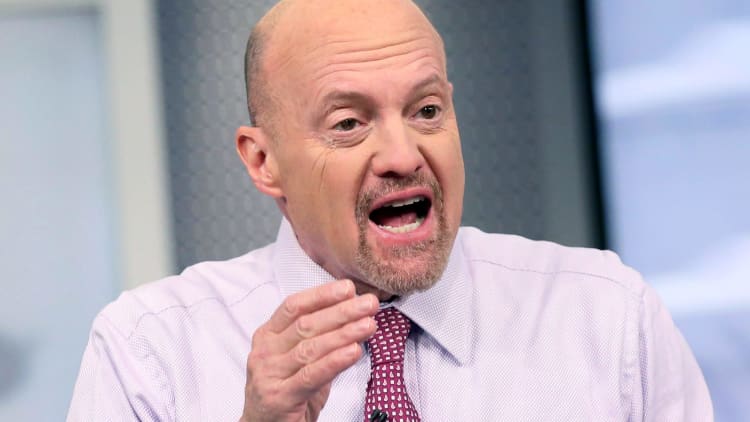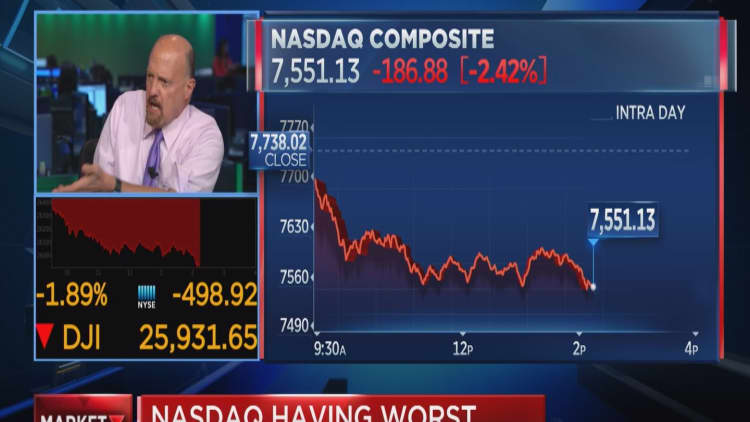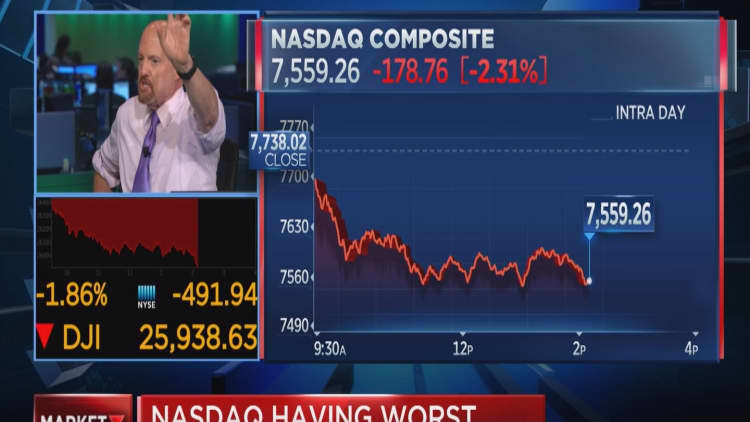
Normally, a stock market sell-off sets off a buying spree in Treasurys, as investors look for security in the more steady government debt market.
But that's not the case now, since Wednesday's sharp plunge in stocks is actually happening because investors have been selling longer-dated Treasurys. As Treasurys are sold, yields, which move opposite price, rise, and that drives up interest rates for a whole range of consumer and business loans.
"There's no flight to safety in bonds. That's a sea change," said Peter Boockvar, chief investment officer at Bleakley Advisory Group.
Analysts say the unusual trade could be a warning that there will be more stock market selling ahead, or at least until investors get scared enough to jump back into Treasurys and markets steady.
The Dow plummeted 831 points, or 3.2 percent, and the S&P 500 fell more than 3.3 percent to close at 2,785.
The 10-year Treasury yield was higher most of the day but edged slightly lower in late trading, to 3.19 percent, off its recent high of 3.26 percent. It was below 3 percent just a month ago. The 30-year bond yield remained higher, however, and was at 3.37 percent as stocks closed for the day.
According to CNBC analysis using Kensho, such a sell-off in stocks typically triggers a "flight to safety" into Treasurys. During the past 20 years, whenever the S&P 500 lost more than 2 percent in a month, Treasurys outperformed. One of the best performing ETFs over the month was iShares 20+ Years Treasury ETF, or TLT, which tracks bonds of longer duration. It averaged a 1.2 percent gain in those occurrences, but other safety plays did not fare nearly as well.
For instance, SPDR Gold Shares ETF GLD was up just a half percent for the month, and an ETF representing investment-grade corporate bonds Vanguard Total Bond Market Index Fund BND, was up 0.3 percent during the month.
The TLT Treasury ETF Wednesday was also going against the grain, trading lower on the day.
"Something occurred in markets today that has been extremely rare this decade," wrote Larry McDonald, head of U.S. macro strategies at ACG Analytics. "In the past 3 years, there have only been 14 trading days [including today] where the S&P 500 [SPY] was lower more than 1% and US bonds [TLT] were also lower on the day. Stocks [and] bonds are wearing a very rare positive correlation." SPY is the SPDR S&P 500 ETF Trust, representing the S&P 500.
Stock-bond correlation breakdown
Since the start of the nine-year bull market, bond prices went up and stock prices went up too, as the Fed and other central banks kept interest rates at zero or even negative. But as the Fed moves forward with its rate hikes, interest rates are rising, breaking correlations that formed in an era of cheap money.
"In this kind of environment, what we've seen in this past year, there are a lot of things that are correlating stocks and bonds in an unusual way, compared to what we've seen over the years," said Andrew Brenner of National Alliance. "Usually when one goes up, the other goes down as a kind of hedge. The central bank has taken risk premia out of the market and now it's starting to come back in and now we're seeing a correlation starting to reverse between stocks and bonds. As long bonds go to higher yields, there seems to be a weakness in large cap technology stocks."

Strategists say if the stock market sell-off becomes bad enough, Treasurys will become a safety zone once more. But as long as the Fed keeps hiking, higher bond yields will continue to siphon funds away from stocks as investors see more attractive yields in fixed-income investments. Those rising interest rates are also a challenge for stocks of companies with high debt levels or those reliant on cheaper credit, such as homebuilders.
Peter Tchir, head of macro strategy at Academy Securities, said there have been just four instances since the beginning of 2016 where the S&P has been down 1.5 percent and long end bond yields have been higher. One of those was Wednesday.
The other three were during times of extreme volatility for stocks, and Wednesday's action could be signaling more volatility ahead. "The first was Jan. 13, 2016. That was when the Chinese repriced the renminbi overnight. Then the last two times were Feb. 2 and Feb. 8 of this year," a volatile week for stocks, he said.
Tchir said it appears risk party funds have been involved in the sell-off.
Raise cash instead
With the traditional safety play not working, investors are clearly making other choices and seeking what have been the safe bets within the stock market.
"[Treasurys] are not a flight to safety, because they're for sale," said Art Hogan, chief market strategist at B. Riley FBR. "Unfortunately that puts you into a flight to safety in a group that's not safe at all in a rising interest rate environment — REITs, utilities and staples. Those stocks have been rising … The best way to be defensive now is to raise cash, not buy bond surrogates."
Boockvar said the bond market had been a positive for stocks until this year. "The Treasury market peaked in the summer of 2016. Bonds have been selling off for the past two years. ... In 2018, you started to reach some trigger points. It hadn't affected stocks, but it affected Italy, Argentina, bitcoin, short VIX. What's happening is when you have a rise in rates to levels where people start to worry, it creates less tolerance for other issues."
He said the stock market became more sensitive to yields when the 10-year yields climbed past 3.11 percent, its previous high. It is now carving out a new range that some bond strategists say could peak at around 3.50 percent before the end of the year.
The recent runup in rates was triggered by comments from Fed Chairman Jerome Powell, who struck a hawkish tone Oct. 3 when he talked about the Fed being far from its neutral rate.
WATCH: Jim Cramer on market sell-off: I really miss Janet Yellen



